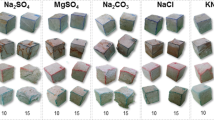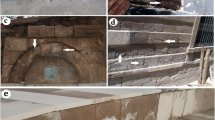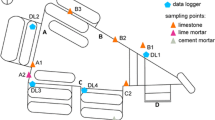Abstract
San Jerónimo Monastery (Granada, Spain) was selected as a case study for the investigation of the effect of indoor environmental conditions on salt weathering and for on-site testing of a remediation treatment using crystallization inhibitors on account of the extreme salt damage affecting both the building stone, a biomicritic limestone, calcarenite and wall paintings. A methodology combining several analysis techniques, phenomenological observations, salt and moisture analysis, environmental monitoring and thermodynamic simulations, was adopted in order to study the salt damage problems affecting this building. Within the collected samples, the majority of salts were found to be magnesium sulphate in the form of either hexahydrite or epsomite, depending on the climate conditions, together with minor amounts of gypsum, nitrates and chlorides. Comparison of empirical observations with thermodynamic simulations of the salt mixture behaviour clearly showed that salt-induced damage events take place during the seasonal changes from spring to summer and winter to spring. An aqueous solution of an organic phosphonate, which in laboratory experiments was found to be an effective inhibitor of magnesium sulphate crystallization, was sprayed over a selected test area of unpainted stonework at the site. Preliminary results seem to indicate that after the application of the treatment both the amount of efflorescence and ongoing damage to the stone support is reduced. However, long-term monitoring of the future condition of the test area is needed to confirm whether indeed this treatment is appropriate and effective in reducing salt damage at this case study site. The outcome of this study extends beyond the particular problems at San Jerónimo Monastery, as it demonstrates a methodological approach for the study and evaluation of salt weathering problems affecting cultural heritage.









Similar content being viewed by others
References
Arnold A, Zehnder K (1991) Monitoring wall paintings affected by soluble salts. In: Cather S (ed) The conservation of wall paintings. The Getty Conservation Institute, Los Angeles
Cardell C, Benavente D, Rodríguez-Gordillo J (2008) Weathering of limestone building material by mixed sulfate solutions. Characterization of stone microstructure, reaction products and decay forms. Mater Charact 59:1371–1385
Cardell-Fernández C (1998) Cristalización de sales en calcarenitas: aplicación al Monasterio de San Jerónimo, Granada (Salt crystalization in calcarenites: application to St. Jerónimo Monastery, Granada) (in Spanish). PhD, University of Granada, Spain
Goudie AS, Viles HA (1997) Salt weathering hazards. Wiley, London
Laue S (2005) Salt weathering of porous structures related to climate changes. Restoration of Buildings and Monuments (Bauinstandsetzen und Baudenkmalpflege) 11:1–10
Lubelli B, Van Hees RPJ (2007) Effectiveness of crystallization inhibitors in preventing salt damage in building materials. J Cult Heritage 8:223–234
Lubelli B, van Hees RPJ, Brocken HJP (2004) Experimental research on hygroscopic behaviour of porous specimens contaminated with salts. Constr Build Mater 18:339–348
Price CA (1996) Stone conservation: an overview of current research. The Getty Conservation Institute, Los Angeles
Price CA (2000) An expert chemical model for determining the environmental conditions needed to prevent salt damage in porous materials. European Commission Research Report No. 11, Protection and Conservation of European Cultural Heritage. Archetype Publications, London
Rodriguez-Navarro C (1994) Causas y mecanismos de alteración de los materiales calcáreos de las catedrales de Granada y Jaén (Causes and mechanisms of decay of the calcareous stones in the Granada and Jaen Cathedrals) (in Spanish). PhD, University of Granada, Spain
Rodriguez-Navarro C, Doehne E (1999) Salt weathering: influence of evaporation rate, supersaturation and crystallization pattern. Earth Surf Process Landf 24:191–209
Rodriguez-Navarro C, Doehne E, Sebastian E (2000) Influencing crystallization damage in porous materials through the use of surfactants: experimental results using sodium dodecyl sulfate and cetyldimethylbenzylammonium chloride. Langmuir 16:947–954
Rodriguez-Navarro C, Linares-Fernández L, Doehne E, Sebastian E (2002) Effects of ferrocyanide ions on NaCl crystallization in porous stone. J Cryst Growth 243:503–516
Rossi Menaresi R, Tucci A (1991) Pore structure and disruptive or cementing effect in salt crystallization in various types of stone. Stud Conserv 36:53–58
Ruiz-Agudo E (2007) Prevención del daño debido a la cristalización de sales en el patrimonio histórico construido mediante el uso de inhibidores de la cristalización (Prevention of salt damage to the built cultural heritage by the use of crystallisation inhibitors) (in Spanish). PhD, University of Granada, Spain
Ruiz-Agudo E, Rodriguez-Navarro C, Sebastian E (2006) The use of additives (phosphonates) as inhibitors for the crystallization of magnesium sulfate. In: Fort R, Alvarez de Buergo M, Gomez-Heras M, Vazquez-Calvo C (eds) Heritage, weathering and conservation. Balkema, New York
Ruiz-Agudo E, Mees F, Jacobs P, Rodriguez-Navarro C (2007) The role of saline solution properties on porous limestone salt weathering by magnesium and sodium sulfates. Environ Geol 52:269–281
Ruiz-Agudo E, Putnis CV, Rodriguez-Navarro C (2008) Interaction between epsomite crystals and organic additives. Cryst Growth Des 8:2665–2673
Sawdy A, Price C (2005a) Salt damage at Cleeve Abbey, England. Part I: a comparison of theoretical predictions and practical observations. J Cult Heritage 6:125–135
Sawdy A, Price C (2005b) Salt damage at Cleeve Abbey, England. Part II: seasonal variability of salt distribution and implications for sampling strategies. J Cult Heritage 6:361–367
Selwitz C, Doehne E (2002) The evaluation of crystallization modifiers for controlling salt damage to limestone. J Cult Heritage 3:20516
Steiger M (2005a) Crystal growth in porous materials—I: The crystallization pressure of large crystals. J Cryst Growth 282:455–469
Steiger M (2005b) Crystal growth in porous materials. II: Influence of crystal size on the crystallization pressure. J Cryst Growth 282:470–481
Steiger M, Linnow K, Juling H, Gülker G, Jarad AE, Von Ossietzky C, Brüggerhoff S, Kirchner D (2008) Hydration of MgSO4·H2O and generation of stress in porous materials. Cryst Growth Des 8:336–343
Winkler EM (1994) Stone in architecture. Springer, Berlin Heidelberg
Acknowledgments
This research was financed by the European Commission VIth Framework Program (contract no. SSP1-CT-2003-501571), the Spanish Government under grant MAT2009-11332, and by research group RNM-179 (Junta de Andalucía, Spain). We thank CEAMA (Junta de Andalucía-Universidad de Granada) for their assistance with ESEM analysis. We are grateful to University of Eindhoven and the Institut für Mineralogie of the University of Münster, for the performance of IC and ICP-AES analysis.
Author information
Authors and Affiliations
Corresponding author
Rights and permissions
About this article
Cite this article
Ruiz-Agudo, E., Lubelli, B., Sawdy, A. et al. An integrated methodology for salt damage assessment and remediation: the case of San Jerónimo Monastery (Granada, Spain). Environ Earth Sci 63, 1475–1486 (2011). https://doi.org/10.1007/s12665-010-0661-9
Received:
Accepted:
Published:
Issue Date:
DOI: https://doi.org/10.1007/s12665-010-0661-9




